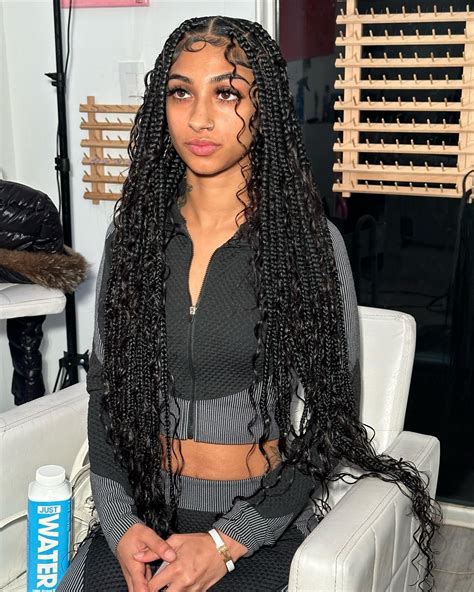Introduction
Human hair braids have captivated fashion-forward individuals for centuries, gracing the heads of countless women and men alike. These versatile braids offer an array of benefits, from enhancing length and volume to adding a touch of glamour and sophistication to any outfit. In this comprehensive guide, we delve into the world of human hair braids, exploring their types, benefits, and the art of caring for these exquisite tresses.

Types of Human Hair Braids
Human hair braids come in a wide array of styles, each offering a unique look and feel. Some of the most popular types include:
- Box Braids: Characterized by their square-shaped pattern, box braids are a versatile style that can be worn in various lengths and sizes.
- Cornrows: Also known as “French braids,” cornrows are flat braids that are typically worn close to the scalp, creating a sleek and intricate look.
- Dreadlocks: A unique and bohemian style, dreadlocks are formed by twisting and matting sections of hair together.
- Micro Braids: As their name suggests, micro braids are incredibly thin, creating a delicate and eye-catching effect.
- Twist Braids: A combination of two strands of hair, twist braids resemble a rope and provide a natural-looking style.
Benefits of Human Hair Braids
Incorporating human hair braids into your hair care routine offers several significant benefits:
- Enhanced Length and Volume: Human hair braids can instantly add significant length and volume to your hair, transforming limp and lackluster tresses into a full and luxurious mane.
- Versatile Styling Options: Human hair braids can be styled in a myriad of ways, allowing you to experiment with different looks to suit any occasion. From sleek buns to intricate updos, the possibilities are limitless.
- Protective Style: Human hair braids offer protection to your natural hair, shielding it from harsh weather conditions, excessive sun exposure, and styling damage.
- Low Maintenance: Braiding your hair significantly reduces the need for daily styling, as braids tend to retain their shape for extended periods. This saves time and effort in your haircare routine.
- Cultural Significance: Human hair braids have deep cultural roots in many African and Caribbean communities, representing tradition, identity, and self-expression.
Choosing the Right Human Hair Braids for You
Selecting the ideal human hair braids for you requires careful consideration of several factors:
- Hair Type: The texture and thickness of your natural hair will influence the type of braids that are most suitable. For example, thicker hair may require larger braids, while fine hair may benefit from smaller braids.
- Desired Style: Determine the specific style of braids you want, taking into account your personal preferences and the occasion for which they are intended.
- Hair Length: Consider the length of your natural hair to ensure that the braids will provide the desired coverage and volume.
- Maintenance Level: Choose braids that fit your lifestyle and maintenance preferences. Some braids require regular touch-ups, while others may require only occasional maintenance.
Caring for Human Hair Braids
Maintaining the health and beauty of your human hair braids is essential for their longevity and effectiveness. Here are some key tips for proper care:
- Regular Washing: Wash your braids every 1-2 weeks using a gentle, sulfate-free shampoo. Avoid using harsh cleansers that can strip away natural oils.
- Conditioning: Condition your braids after each wash to restore moisture and prevent breakage. Use a deep conditioner once a month to nourish and revitalize your braids.
- Moisturizing: Apply a leave-in conditioner or braid spray regularly to keep your braids hydrated and prevent dryness.
- Regular Maintenance: Visit your hairstylist every 6-8 weeks for touch-ups and tightening to ensure that the braids remain secure and looking their best.
- Avoid Heat Styling: Excessive heat can damage human hair braids, so minimize the use of hot styling tools. If you must use heat, always apply a heat protectant spray to minimize damage.
Conclusion
Human hair braids offer an elegant and versatile way to enhance your hair and express your personal style. By choosing the right braids for your needs and following proper care practices, you can maintain healthy, beautiful braids that will turn heads and boost your confidence. Embrace the transformative power of human hair braids and elevate your tresses to new heights of glamour and sophistication.
FAQs
-
Q: How long do human hair braids last?
A: The longevity of human hair braids varies depending on the type of braid, hair care practices, and individual hair growth patterns. With proper care, braids can typically last for 4-8 weeks. -
Q: Can I dye human hair braids?
A: Yes, human hair braids can be dyed, but it is recommended to consult with a professional hairstylist to ensure that the dye is compatible with the type of braid and to minimize damage. -
Q: Do human hair braids damage my natural hair?
A: When installed and maintained properly, human hair braids do not typically damage natural hair. In fact, they can offer protection from harsh elements and styling damage. However, excessively tight braids or poor maintenance techniques can lead to hair breakage. -
Q: How much do human hair braids cost?
A: The cost of human hair braids varies depending on the type of braid, length, and stylist. On average, you can expect to pay anywhere from $100 to $500 for a full head of braids.
